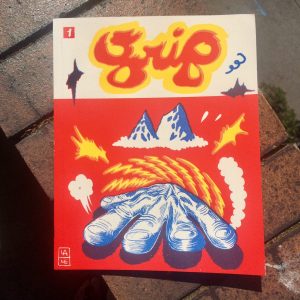Sally Ingraham here with a look at Lale Westvind’s Grip Vol. 1!
—————————————————————————————————
I am usually swept along by Lale Westvind‘s work, but her latest comic – Grip Vol. 1 – swept me away. It “grips” you immediately, as your eye catches sight of the bright screen-printed cover and the lovely risograph interiors. The rise of riso printing has brought a wealth of pretty books, but a pretty book does not always equal a great comic. Lale’s voracious drawing style and the way she bends the comics medium to her will is in this case thrillingly complimented by the work of Chicago-based Perfectly Acceptable Press.
Lale’s storytelling is particularly good in this comic. It begins with a transformative encounter with a force that sets the hands of the protagonist in motion. Her hands remain the focus of the story throughout, visually and thematically. She moves from one adventure to another, from one job to the next, meeting people and traveling, and her hands manipulate and influence what happens around her both at her will and perhaps against it.
Without words and using only a few written sound effects, Lale Westvind crafts a moving tribute to working women, a wild celebration of female power and skill. Whether sorting mail, serving tables, piloting aircraft, traversing mountain heights, or sharing long significant eye-contact, the women in Lale’s comic are moving, building, holding the world together while tearing it apart.
Although there is no regular rhythm in the structure of the panels, there are a lot of interesting design choices from spread to spread. There are visual rhymes and mirroring that I find satisfying, and a color scheme that balances and harmonizes with the lines.
Grip Vol. 1 mixes reality with fantasy in a way that feels familiar to me. It’s like Lale got inside my head – and likely the heads of many women – and illustrated how the work of the moment, the task at hand, is transformed by the inner fantasies and landscapes of the heart, the joyous and violent riot of thought that leads to action or survival. Whether physically or metaphorically, often getting a grip and keeping it becomes the only motion that really matters.
Recommended. Get a copy of the comic HERE!
—————————————————————————————————
Suzy and Cecil – 7-20-2018 – by Sally Ingraham






These pages are absolutely stunning, and the book sounds like a real joy. Lale Westvind’s now on my radar — thanks for sharing, Sally!